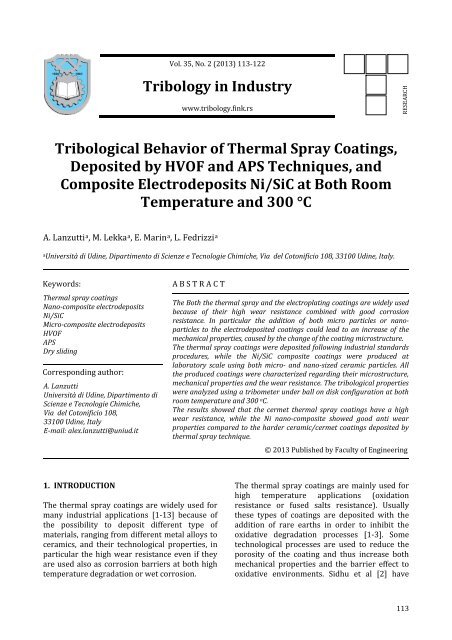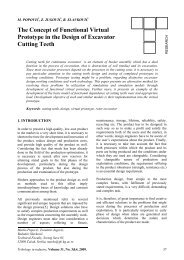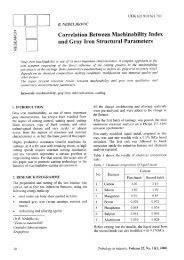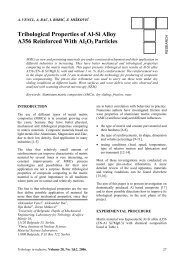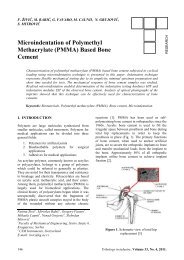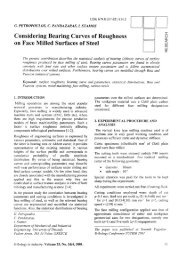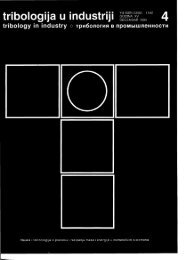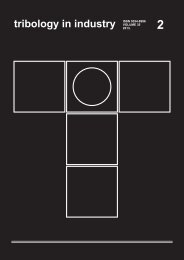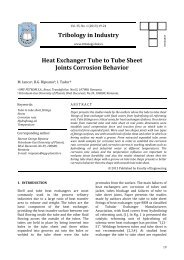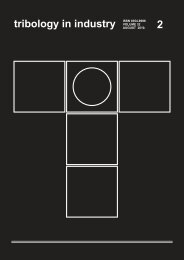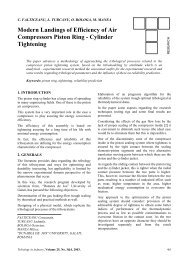Tribological Behavior of Thermal Spray Coatings, Deposited by ...
Tribological Behavior of Thermal Spray Coatings, Deposited by ...
Tribological Behavior of Thermal Spray Coatings, Deposited by ...
Create successful ePaper yourself
Turn your PDF publications into a flip-book with our unique Google optimized e-Paper software.
A. Lanzutti at al., Tribology in Industry Vol. 35, No. 2 (2013) 113‐122coatings with the anti‐wear properties <strong>of</strong> the Nicomposite coating, highlighting the importantproperties <strong>of</strong> the composite coatings producedwith a simple and cheaper technique comparedto the thermal spray process.2. EXPERIMENTALa. Samples productionFor all types <strong>of</strong> the deposits ASTM 387 F22 steelplates (7×10 cm) and discs (d=5 cm) have beenused as substrates (chemical composition inTable 1).Table 1. Chemical composition <strong>of</strong> steel substrateASTM 387 F22.C Si Mn P Cr Mo Fe0.11 0.31 0.5 0.025 2.2 0.9 Bal.The thermal spray coatings have been depositedusing industrial procedures. The depositedcoatings were: NiCr 80/20 and NiCr 80/20 +Cr 2 O 3 deposited <strong>by</strong> APS (Air Plasma <strong>Spray</strong>)technique and WC CoCr 18/4 deposited <strong>by</strong> HVOFtechnique.Regarding the Ni matrix coatings, three types <strong>of</strong>deposits have been prepared: pure Ni (to beused as reference). Ni containing microparticles<strong>of</strong> SiC and Ni containing nanoparticles <strong>of</strong> SiC.The electroplating bath used was a high speednickel sulfammate plating bath having thefollowing composition: 500 g/l Ni(SO3NH 2 ) 2.4H 2 O, 20 g/l NiCl 2.6H 2 O, 25 g/l H 3 BO 3 , 1ml/l surfactant (CH 3 (CH) 11 OSO 3 Na basedindustrial product. The deposition was carriedout using a galvanic pilot plant (12 l platingtank) under galvanostatic control at 4 A/dm 2 ,50 °C, under continuous mechanical stirring.The deposition time was 2.5 h in order toobtain 70–80 μm thick deposits. For theproduction <strong>of</strong> the composite coatings 20g/l <strong>of</strong>micro‐ or nano‐powders were added into theelectroplating bath, dispersed usingultrasounds (200 W, 24 kHz) for 30 min andthen maintained in suspension undercontinuous mechanical stirring during theelectrodeposition. The micro‐particles have amean dimension <strong>of</strong> 2μm and a very irregularand sharp shape, while the nano‐particles havea mean diameter <strong>of</strong> 45 nm [21].b. Samples characterizationThe specimens characterization includesmicrostructure, chemical composition,microhardness, wear resistance at both roomtemperature and 300 °C and corrosionresistance in two different environments.The microstructure <strong>of</strong> the specimens have beenanalysed <strong>by</strong> SEM (Zeiss Evo‐40) + EDXS (Oxfordinstruments INCA) in cross section. Both the SiCcontent and the coatings’ porosity werecalculated using an image analysis s<strong>of</strong>tware [13].For nano composite coating The SiC content wasmeasured through the measurements <strong>of</strong> RFGDOES (HR‐Pr<strong>of</strong>ile, Horiba Jobin Yvon),calibrated using 28 CRM (Certified ReferenceMaterial) samples. The system was set up usingan Ar pressure <strong>of</strong> 650Pa and a applied power <strong>of</strong>50 W. The micro‐composite coating were notanalysed <strong>by</strong> the GDOES because <strong>of</strong> some issuesrelated to the plasma erosion <strong>of</strong> the reinforcingparticles [21].Micro‐hardness measurements (HV 0,3 ) havebeen performed on cross section <strong>of</strong> thespecimens.Wear tests have been performed using a CETRUMT tribometer in a ball‐on‐disc configuration[25] at both room temperature and at 300 °C.The testing parameters are summarized in Table2. The volume loss has been evaluated using astylus pr<strong>of</strong>ilometer (DEKTAK 150 Veeco). Thewear rate K [10 −6 mm 3 /Nm] has been calculatedusing the equation described in [26].Table 2. Wear test parameters.Counter material WC sphere (d 9.5 mm)Applied load70 NTest radius18 mmRotation speed300 rpmSliding speed0.565 m/sTest duration60 min3. EXPERIMENTAL RESULTSa. Microstructural characterizationIn Fig. 1 is shown the microstructure <strong>of</strong> the steelsubstrate. The Gr 22 steel presents a ferriticmicrostructure with some carbides precipitatedin the metal matrix, that leads to the high creep115
A. Lanzutti at al., Tribology in Industry Vol. 35, No. 2 (2013) 113‐122strength <strong>of</strong> material. The carbides are mainlyproduced <strong>by</strong> Cr and Mo. The hardness <strong>of</strong> thematerial is about 180±20 HV 0,3 and the ferriticgrain size is about 45±15 µm.c)Fig. 2. SEM images and microstructuralcharacterization <strong>of</strong> thermal spray coatings: a) NiCr80/20, b) WC CoCr 18/4 and c) NiCr 80/20+ Cr 2 O 3 .Fig. 1. Microstructure <strong>of</strong> gr. 22 steel.In Fig. 2 are shown the SEM micrographsobtained for <strong>Thermal</strong> spray coatings and therelative data acquired <strong>by</strong> mechanicalcharacterization and image analysis. In Tab. 3the thermal spray coatings’ properties are listed.a)b)Table 3. Results <strong>of</strong> thermal spray coatings’characterization.Coating Thickness Porosity Hardness HV0,3[µm] vol.%NiCr 98±16 6.5 359±18WCCoCr 105±15 3.45 1027±21NiCr+Cr2O3 (38+187) ± 25 5.5+10.1 (341+1118) ±24As can be observed, the three types <strong>of</strong> thermalspray coatings present different thickness andporosity. The porosity, acquired <strong>by</strong> imageanalysis, is higher for the coatings deposited <strong>by</strong>APS technique compared to the HVOF deposits.This difference could be related to both powderssize and impact velocity that is lower in APStechnique with respect to HVOF. Indeed, thedifference in kinetic energy <strong>of</strong> the moltenpowders, that is higher in HVOF technique, leadsto a different density on deposited coating. Thehardness acquired is associated to the materialdeposited and the values acquired are similar todata available in scientific literature for thermalspray coatings [1‐13].The SEM micrographs obtained on cross section<strong>of</strong> Ni/SiC composite coatings previously etched(acetic acid: nitric acid 1:1) are shown in Fig. 3.In Table 4 are listed the electrodepositedcoatings’ properties.Table 4. A result <strong>of</strong> Ni/SiC electrodepositscharacterization.Coating Thickness[µm]SiC wt.% HardnessHV0.3Ni 78±7 ‐ 172±7Ni/µSiC 73±8 0.8 247±8Ni/nSiC 75 ± 5 0.15 270 ±9116
A. Lanzutti at al., Tribology in Industry Vol. 35, No. 2 (2013) 113‐122a)b)micro‐particles leads to a microstructurecolumnar with a slight modification <strong>of</strong>orientation, caused probably <strong>by</strong> the deviation <strong>of</strong>electrical field in proximity <strong>of</strong> ceramic particlesthat are in non‐conductive material. On thecontrary, the addition <strong>of</strong> nanoparticles gives agrain refinement and a multi‐orientation <strong>of</strong>columns. The SiC amount is higher in the microcompositecoatings compared to the nanocompositeone. The addition <strong>of</strong> particles leads toa noticeable microhardness increase due to boththe presence <strong>of</strong> the particles and the grainrefinement.All the analysed samples showed a surfaceRoughness Ra <strong>of</strong> about 0.5µm, obtained after thesurface’ grinding.b. <strong>Tribological</strong> characterizationAll the wear tracks obtained for both bare steel,thermal spray and composite electrodeposits atboth room temperature and 300 °C are shown inFigs. 4‐6.c)In Fig. 4 the top views <strong>of</strong> the wear tracksobtained for gr. 22 steel are shown, tested atboth room temperature and 300 °C.Room temperature 300°CFig. 3. SEM images and microstructuralcharacterization <strong>of</strong> electrodeposited coatings:a) pure Ni, b) Ni/µSiC and c) Ni/nSiC.The microstructure <strong>of</strong> the electrodeposits iscolumnar. In the case <strong>of</strong> the pure Ni the metalcolumns are oriented along the direction <strong>of</strong>electrical fields. The addition <strong>of</strong> SiC microparticlesleads to a slight modification <strong>of</strong> the Nicolumns orientation and size. On the other hand,the codeposition <strong>of</strong> SiC nano‐particles leads tothe formation <strong>of</strong> a fine grained deposit in whichthe Ni columns are not oriented. The addition <strong>of</strong>Fig. 4. SEM images <strong>of</strong> the wear tracks obtained for thebare steel at both RT and 300 °C.The steel is subjected to triboxidative wear atboth room temperature and 300 °C. At roomtemperature the oxide produced is adherent tometal substrate and very homogeneus. At 300 °Cthe oxide produced is concentrated on the weartrack’ sides. This phenomenon is related to theloss <strong>of</strong> mechanical properties <strong>of</strong> the substratesthat permits the countermaterial to destroy theoxide layer that is thus deposited on the sides <strong>of</strong>the wear track. At 300 °C are highlighted the117
A. Lanzutti at al., Tribology in Industry Vol. 35, No. 2 (2013) 113‐122debris <strong>of</strong> both oxide and steel along the borders<strong>of</strong> wear track.In Fig. 5 the top views <strong>of</strong> the wear tracksobtained for thermal spray coatings are shown,tested at both room temperature and 300 °C.For the metal matrix deposits the degradationmechanism is a triboxidation at both roomtemperature and 300 °C, which intensity isvarying in function <strong>of</strong> the coating material.In particular the thermal spray coatings showedalso other degradation mechanisms which arerelated to their microstructure.Room temperature 300°Ctests the detachment is decreased due to apossible hardness decrease <strong>of</strong> the materialwhich allowed the sealing <strong>of</strong> porosity, thusreducing the contact fatigue failure. The cermetcoatings were all subjected to triboxidation <strong>of</strong>metal matrix, more intense at high temperature.For the ceramic material (Cr 2 O 3 ) the degradationmechanism at room temperature is similar tothe NiCr coating while at high temperature testthe degradation becomes more intense. This iscaused <strong>by</strong> a phase change <strong>of</strong> chromium oxidewhich enhances the wear ratio and reduces atthe same time the friction coefficient [4].In Fig. 6 are shown the top views <strong>of</strong> the weartracks obtained for Ni/SiC electrodeposits testedat both room temperature and 300 °C.Room temperature 300°CNiNiCrWC CoCrNi/µSiCNiCr+Cr2O3Ni/nSiCFig. 5. SEM images <strong>of</strong> the wear tracks obtained for thethermal spray coatings at both RT and 300 °C.The Ni/Cr showed a material detachmentoriginated <strong>by</strong> contact fatigue phenomenon,aggravated <strong>by</strong> its porosity. At high temperatureFig. 6. SEM images <strong>of</strong> the wear tracks obtained for theNi/SiC deposits at both RT and 300°C.118
A. Lanzutti at al., Tribology in Industry Vol. 35, No. 2 (2013) 113‐122The Ni electrodeposits showed, at roomtemperature, a triboxidation with a descaling <strong>of</strong>oxide which forms a third body between thecounter material and the wear track, thusleading to the formation <strong>of</strong> secondary tracksrelated to abrasive wear. At high temperaturethe coatings showed a strong triboxidation. ByEDXS analysis on pure Ni coatings, it wasdetected that during the wear test the steelsubstrate was reached. For the composite Ni/SiCcoatings it seems that the oxide produced ismore adherent to steel substrate at hightemperature. Probably both the grainrefinement and the presence <strong>of</strong> ceramic particlesare linking the oxide to the metal matrix. Itseems that some counter‐material wastransferred to the coating surface, due to slightadhesion phenomena.The wear rate <strong>of</strong> all tested coatings at both roomtemperature and 300 °C are shown in Fig. 7.temperature one and this could be related toboth high oxidation resistance <strong>of</strong> the materialthat contains a high amount <strong>of</strong> Cr and to thereduction <strong>of</strong> material detachment thatconsequently reduces the abrasive phenomena.The ceramic coating (Cr 2 O 3 ) showed a high wearrate at 300 °C tests due to phase change <strong>of</strong>chromium oxide under tribological contact.The electrodeposits showed good wearresistance at room temperature, higher for thenano‐composite coating. This reduction in wearrate could be related to the grain refinement <strong>of</strong>microstructure <strong>of</strong> the metal matrix, whichincreases also the mechanical properties <strong>of</strong> thecoating. This effect is not visible in the microcompositecoatings because the reinforcementparticles are usually detached from the metalmatrix leading to intensive abrasive wear caused<strong>by</strong> hard particle third body contact betweencounter material and surface <strong>of</strong> the specimen. Athigh temperature the mechanical behaviour <strong>of</strong>the coating is reduced, probably because <strong>of</strong> thehardness decrease. In this case the pure Nicoating is completely removed while the microcomposite coating showed a better wearresistance, compared to the pure Ni one, but thewear rate values were still higher than thethermal spray coatings wear rates. The higherwear resistance <strong>of</strong> the nano‐composite coatingat 300 °C is probably related to the highermechanical properties <strong>of</strong> the metal matrixcompared to the other electrodeposits.Fig. 7. Wear rates graph at both room temperatureand 300 °C for all the coatings tested.All the coatings protect the steel substrateduring the test, except for the pure Ni coatingthat showed, at 300 °C, the highest wear rate. Itis possible to observe that the cermet coatinghas the lowest wear rate compared to the othercoatings at both test temperatures. This isrelated to the high amount <strong>of</strong> WC which isbonded <strong>by</strong> a metal matrix that has highoxidation resistance at the test temperatures.For this coating the wear resistance is associatedto the carbide component and the particlesbinding is related to the metal matrix which hasa high toughness. On the other hand, the NiCrcoating showed a lower wear rate at hightemperature tests, compared to the roomIn Figs. 8‐9 the COF (Friction Coefficients <strong>of</strong> thetested materials) are shown. For all the testperformed on thermal spray coatings, it ispossible to observe that the COF values, at theend <strong>of</strong> the test, are comparable between thetests performed at different temperature, apartthe ceramic coating that showed a lower COF athigh temperature due to the change phase <strong>of</strong>ceramic oxide under hertzian loads. The NiCrcoatings showed a noisy COF graph because <strong>of</strong>the coating material detachment that producedabrasive particles that dissipated more energy,required to move the particles in the hertziansystem. At high temperature there is a start atlow COF and, at regime, it reached the samevalues <strong>of</strong> the test at room temperature. Probablyduring the start <strong>of</strong> the test the surface <strong>of</strong> thesample was covered <strong>by</strong> a oxide layer producedduring the heat up <strong>of</strong> the system. The presence119
A. Lanzutti at al., Tribology in Industry Vol. 35, No. 2 (2013) 113‐122<strong>of</strong> oxide decreased the surface energy inproximity <strong>of</strong> the hertzian contact <strong>of</strong> the twomaterials, reducing the friction coefficient. Whenthe oxide was broken the contact between thetwo materials was between the WC and theNi/Cr slightly oxidized.COF [-]RT test300°C testTime [s]a)COF [-] COF [-]Time [s]a)b)Time [s]COF [-] COF [-]RT test300°C testRT test300°C testTime [s]Time [s]Fig. 8. COF graphs at both room temperature and 300°C for the thermal spray coatings: a) NiCr 80/20, b)Wc Co Cr (18/4), c) NiCr 80/20+ Cr 2 O 3 .b)c)Fig. 9. COF graphs at both room temperature and 300°C for the Ni/SiC composite coatings: a) Roomtemperature test, b) 300 °C.For the WC‐CoCr coating the COF are slightlydifferent and this is caused mainly <strong>by</strong> thenumber <strong>of</strong> third body particles produced duringthe test. Indeed is possible that at hightemperature the amount <strong>of</strong> abrasive particles,that are taking part to the hertzian system, arehigher due to the intense triboxidation thatcause probably a high amount <strong>of</strong> descaled oxide.At the end <strong>of</strong> the test part <strong>of</strong> the particles areevacuated from the wear track reaching a COFvalue comparable with the room temperature test.The COF acquired from the test performed at 300°C is lower compared to the value acquired atroom temperature test. This behaviour is relatedto the change phase <strong>of</strong> ceramic oxide thatdecreased the contact energy and thus the COF.The friction coefficient values are higher at thestart <strong>of</strong> the test because <strong>of</strong> possible partialfragmentation <strong>of</strong> the material caused <strong>by</strong> brittlecontact between the countermaterial and thecoating. This leads to have an high amount <strong>of</strong> thirdbody particles that increase the COF value, at thebeginning, that is decreasing, during the test,because <strong>of</strong> particle’ evacuation form the wear trackcaused <strong>by</strong> the relative motion <strong>of</strong> the two materials.120
A. Lanzutti at al., Tribology in Industry Vol. 35, No. 2 (2013) 113‐122The COF acquired for the Ni/SiC electrodeposits islower compared to the pure Ni electrodeposit. Thiscould be related to both different mechanicalproperties <strong>of</strong> the composite material respect to thepure Ni and possible interactions <strong>of</strong> SiC particleswith countermaterial that could lower the surfaceenergy and interaction <strong>of</strong> the 2 surfaces.At high temperature the COF graphs are verysimilar and this behaviour could be related to thechange <strong>of</strong> contact, compared with roomtemperature test that is between Ni oxide and theWC sphere, instead <strong>of</strong> Ni slightly oxidized and WC.4. CONCLUSIONSIn this work different type <strong>of</strong> coatings have beenanalysed deposited either <strong>by</strong> thermal spraytechniques or <strong>by</strong> electrodeposition. The coatingsdeposited <strong>by</strong> thermal spray are: NiCr (APS), WCCoCr (HVOF) and NiCr+Cr 2 O 3 (APS) . Theelectrodeposits are Ni/SiC coatings with nano‐ ormicro‐sized particles embedded in metal matrix.The analysed coatings showed differentmicrostructure that depends on both depositedmaterial and deposition technique.Regarding the wear properties, the steel substrateshowed the worst wear resistance at both roomtemperature and 300 °C. This behaviour is relatedto the low mechanical properties <strong>of</strong> this steel thatare decreasing as the temperature increases.All the tested metal matrix coatings underwenttriboxidation that was increased at hightemperature test. The triboxidation behaviourdepends on metal oxidation resistance. The ceramiccoating was subjected to an intensive materialdetachment, caused mainly <strong>by</strong> the highinterconnected porosity <strong>of</strong> the thermal sprayedcoating. The detachment increased in function <strong>of</strong>temperature because the ceramic oxide changedphase under the hertzian loads. For all the metalmatrix coatings was present a third body abrasioncaused mainly <strong>by</strong> both oxide descaling and ceramicreinforcement detachment from the metal matrix.Observing the wear rates, the WC CoCr coatingshowed the highest wear resistance at bothroom temperature and 300 °C. This behaviour isrelated to the microstructure <strong>of</strong> the deposit: thereinforcing particles (WC) give high hardnessalso at high temperature and the metal matrix(CoCr) increases the toughness <strong>of</strong> the coatingand acts as binder for the reinforcing particles.The electrodeposits Ni/nSiC showed a wearbehaviour that is comparable with the WC CoCrone. For the nano‐composite electrodeposits thesynergy <strong>of</strong> both grain refinement and nanoparticlesembedding leads to an increase <strong>of</strong>hardness at both room temperature and 300 °C.This effect probably enhances the wearresistance <strong>of</strong> the Ni metal matrix that issubjected to hertzian loads.The COF values are strongly dependent on thematerial analysed but it was observed, forthermal spray coating, similar COF valuesbetween the room temperature test and the 300°C tests. The ceramic coating showed the lowestCOF values at high temperature caused mainly<strong>by</strong> the production <strong>of</strong> brittle CrO 2 phase. Theelectrodeposits showed some differences in theCOF values between the high temperature testsand the room temperature tests caused mainly<strong>by</strong> the change <strong>of</strong> hertzian contact from Nislightly oxidized, at room temperature, to Nistrongly oxidized, at 300 °C. At roomtemperature is visible a different in COF valuebetween pure metal and composite coatings.This effect is related to the different mechanicalproperties <strong>of</strong> the coating and the possibleinteraction <strong>of</strong> reinforcing particles with thecountermaterial in the hertzian contact/motion.REFERENCES[1] N.F. Ak, C. Tekmen, I. Ozdemir, H.S. Soykan, E.Celik: NiCr coatings on stainless steel <strong>by</strong> HVOFtechnique, Surface and coatings technology, Vol.173‐174, pp. 1070‐1073, 2003.[2] B.S. Sidhu, D. Puri, S. Prakash: Mechanical andmetallurgical properties <strong>of</strong> plasma sprayed andlaser remelted Ni‐20Cr and stellite‐6 coatings,Journal <strong>of</strong> Materials Processing Technology, Vol.159, pp. 347‐355, 2005.[3] H. Singh, D. Puri, S. Prakash: Some studies on hotcorrosion performance <strong>of</strong> plasma sprayedcoatings on Fe‐based superalloy, Surface &coatings technology, Vol. 192, pp. 27‐38, 2005.[4] H.S. Ahn, O.K. Kwon: <strong>Tribological</strong> behaviour <strong>of</strong>plasma‐sprayed chromium oxide coating, Wear,Vol. 225‐229, pp. 814‐824, 1999.[5] G. Bolelli, V. Cannillo, L. Lusvaraghi, T.Manfredini: Wear behaviour <strong>of</strong> thermally sprayed121
A. Lanzutti at al., Tribology in Industry Vol. 35, No. 2 (2013) 113‐122ceramic oxide coatings, Wear, Vol. 261, pp. 1298‐1315, 2006.[6] E.M. Leivo, M.S. Vippola, P.P.A. Sorsa, P.M.J.Vuoristo, T.A. Mantyla: Wear and corrosionproperties <strong>of</strong> plasma sprayed Al2O3 and Cr2O3coatings sealed <strong>by</strong> aluminum phosphates, Journal<strong>of</strong> <strong>Thermal</strong> spray technology, Vol. 6, pp. 205‐210, 1997.[7] L. Fedrizzi, L. Valentinelli, S. Rossi, S. Segna:Tribocorrosion behaviour <strong>of</strong> HVOF cermetcoatings, Corrosion Science, Vol. 49, pp. 2781‐2799, 2007.[8] D. Toma, W. Brandl, G. Maringean: Wear andcorrosion behavior <strong>of</strong> thermally sprayed cermetcoatings, Surface and coatings technology, Vol.138, pp. 149‐158, 2001.[9] L. Fedrizzi, S. Rossi, R. Cristel, P.L. Bonora:Corrosion and wear behaviour <strong>of</strong> HVOF cermetcoatings used to replace hard chromium,Electrochimica Acta, Vol. 49, pp. 2803‐2814, 2004.[10] P.L. Ko, M.F. Robertson: Wear characteristics <strong>of</strong>electrolytic hard chrome and thermal sprayedWC‐10Co‐4Cr coatings sliding against Al‐Nibronze in air at 21°C and at ‐40°C, Wear, Vol.252, pp. 880‐893, 2002.[11] J.K.N. Murthy, D.S. Rao, B. Venkataraman: Effect<strong>of</strong> grinding on the erosion behavior <strong>of</strong> a WC‐Co‐Crcoating deposited <strong>by</strong> HVOF and detonation gunspray process, Wear, Vol. 249, pp. 592‐600, 2001.[12] C.W. Lee, J.H. Han, J. Yoon, MC Shin, S.I. Kwun: Astudy on powder mixing for high fracturetoughness and wear resistance <strong>of</strong> WC‐CO‐Crcoatings sprayed <strong>by</strong> HVOF, Surface and coatingstechnology, Vol. 204, pp. 2223‐2229, 2010.[13] N. Popa, C. Onescu: About the <strong>Tribological</strong>Behaviour <strong>of</strong> Ceramic Materials, Tribology inIndustry, Vol. 30, No. 3&4, pp. 10‐14, 2008.[14] A. Koutsomichalis, N. Vaxenvadis, G.Petropoulos, E. Xatzaki, A. Mourlas, S. Antoniou:<strong>Tribological</strong> <strong>Coatings</strong> for Aerospace Applicationsand the Case <strong>of</strong> WC‐Co Plasma <strong>Spray</strong> <strong>Coatings</strong>,Tribology in Industry, Vol. 31, No. 1‐2, pp. 37‐42, 2009.[15] S. Deshpande, A. Kulkarni, S. Sampath, H.Herman: Application <strong>of</strong> image analysis forcharacterization <strong>of</strong> porosity in thermal spraycoatings and correlation with small angle neutronscattering. Surface and coatings technology, Vol.187, pp. 6‐16, 2004.[16] I. Garsia, J. Fransaer, J.P. Celis: Role <strong>of</strong> contactfrequency on the wear rate <strong>of</strong> steel in discontinuoussliding contact conditions, Surface and <strong>Coatings</strong>technology, Vol. 141, pp. 171‐178, 2001.[17] A.F. Zimmermann, G. Palumbo, K.T. Aust, U. Erb:Mechanical properties <strong>of</strong> Ni silicon carbidenanocomposites, Material Science andEngineering, Vol. A328, pp. 137‐146, 2002.[18] A.F. Zimmermann, D.G. Clark, K.T. Aust, U. Erb,pulse electroideposition <strong>of</strong> Ni‐SiC nanocomposite,Material Letters, Vol. 52, pp. 85‐90, 2002.[19] L. Benea, P.L. Bonora, A. Borello, S. Martelli, F.Wenger, P. Ponthiaux, J. Galland: Preprataionand investigation <strong>of</strong> nanostructured SiC‐Ni layers<strong>by</strong> electrodeposition, Solid State Ionics, Vol. 151pp. 89‐95, 2002.[20] L. Benea, P.L. Bonora, A. Borello, S. Martelli: Wearcorrosion properties <strong>of</strong> nano‐structured SiC‐Nicomposite coatings obtained <strong>by</strong> electroplating,Wear, Vol. 249, pp. 995‐1003, 2002.[21] M. Lekka, A. Lanzutti, A. Casagrande, C. deLeitenburg, P.L. Bonora, L. Fedrizzi: Room andhigh temperature wear behaviour <strong>of</strong> Ni matrixmicro. Nano‐SiC composite electrodeposits,surface and coatings technology, Vol. 206, pp.3658‐3665, 2012.[22] M. Lekka, P.L. Bonora, A. Lanzutti, S. Benoni, P.Caoduro, L. Fedrizzi: Industrialization <strong>of</strong> NimicroSiCelectrodeposition on copper moulds forsteel continuos casting, Metallurgia italiana, Vol.6, pp. 1‐7, 2012.[23] A.A. Cerit, M.B. Karamis, F. Nair, K. Yldizli: Effect<strong>of</strong> Reinforcement Particle Size and VolumeFraction on Wear Behaviour <strong>of</strong> Metal MatrixComposites, Tribology in Industry, Vol. 30, pp.31‐36, 2008.[24] A. Lanzutti, E. Marin, M. Lekka, P. Chapon, L.Fedrizzi: Rf‐GDOES analysis <strong>of</strong> compositemetal/ceramic electroplated coatings with nanotomicroceramic particles’ size: issues in plasmasputtering <strong>of</strong> Ni/micro‐SiC coatings, SIA, Vol. 44,pp. 48‐45, 2012.[25] A. Minewitsh: Some Developments inTriboanalysis <strong>of</strong> Coated Machine Components,Tribology in Industry, Vol. 33, pp. 31‐36, 2011.[26] K. Holmberg, A. Matthews: <strong>Coatings</strong> tribology:Properties, Mechanisms, Techniques andApplications in Surface engineering, Elsevier, UK,2009.122


